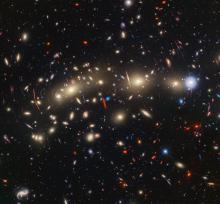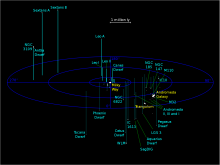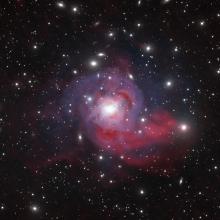Listen to today's episode of StarDate on the web the same day it airs in high-quality streaming audio without any extra ads or announcements. Choose a $8 one-month pass, or listen every day for a year for just $30.
You are here
Local Group
If you look at a map of just about any state, you’ll see a few major cities, a few more mid-sized ones, and a whole bunch of small towns. And the same thing happens if you look at a map of our region of intergalactic space. There are a couple of giant galaxies, a few mid-sized ones, and a whole bunch of little ones. And they are all bound to each other by their mutual gravitational pull.
This collection of galaxies is known as the Local Group. It spans about 10 million light-years, and contains dozens of galaxies, with new ones added to the list every year.
The “big cities” of the Local Group are our home galaxy, the Milky Way, and the Andromeda galaxy, M31. Each is a disk that’s at least a hundred thousand light-years wide, and contains hundreds of billions of stars.
After these two behemoths, the list includes a few mid-size galaxies. The largest is the Triangulum galaxy. It’s about half the diameter of M31 and the Milky Way, but only about one-tenth as massive.
A couple of other mid-size galaxies are satellites of M31. One is a spiral, while the other is a small elliptical galaxy, which looks like a fuzzy rugby ball. And two more members of the mid-size brigade orbit the Milky Way — the Large and Small Magellanic Clouds.
Most of the remaining members of the Local Group are tiny. Some contain only millions of stars, not the billions found in the larger galaxies. And many of them are satellites of the Milky Way. More about that tomorrow.
Script by Damond Benningfield






